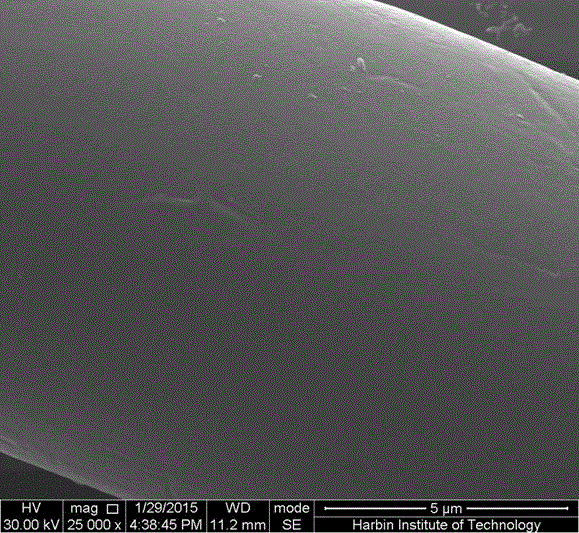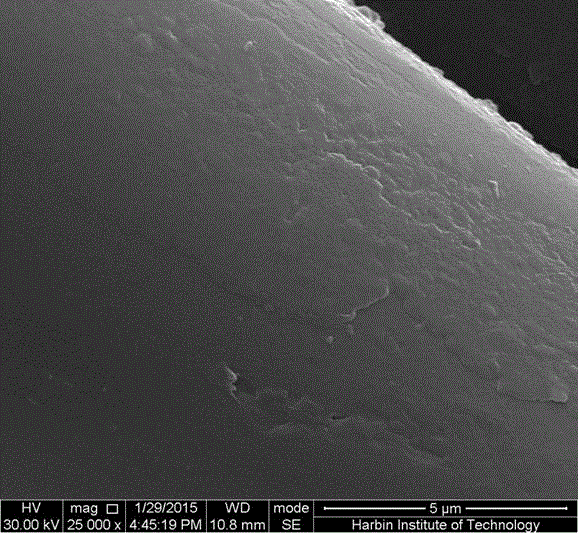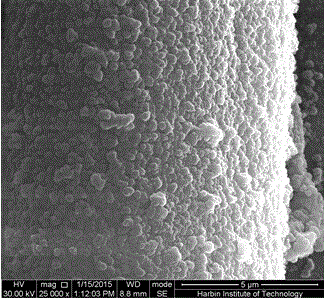Super-hydrophobic and -oleophylic cloth producing method
A super-hydrophobic and super-oleophilic technology, applied in fiber types, textiles and papermaking, fiber treatment, etc., can solve the problems of unfavorable application and cost increase, and achieve the effects of scale-up production, low cost and simple steps
- Summary
- Abstract
- Description
- Claims
- Application Information
AI Technical Summary
Problems solved by technology
Method used
Image
Examples
Embodiment 1
[0031] Embodiment 1: Preparation of superhydrophobic superoleophilic cloth
[0032] (1) Put the fabric (polyester) in ethanol for 30 minutes of ultrasonic treatment;
[0033] (2) Dissolve 0.2g of dopamine hydrochloride and 0.1g of folic acid in 100 mL of water, and stir at 60°C for 6 hours;
[0034] (3) Use sodium hydroxide to adjust the pH value of the above mixed solution to 8, then add the washed cloth and stir at room temperature for 9 hours to obtain a cloth with obvious hierarchical structure on the surface (such as image 3 shown).
[0035] (4) Take out the cloth, wash it with ethanol, put it in the ethanol solution of octadecylamine, the concentration of octadecylamine is 10 mmol L -1 , after 24 hours of reaction, the superhydrophobic and superoleophilic fabric was obtained with a water contact angle of 162 o (Such as Figure 4 shown), the toluene contact angle is 0 o (Such as Figure 5 shown).
Embodiment 2
[0036] Embodiment 2: Preparation of superhydrophobic superoleophilic cloth
[0037] (1) Put the cloth (cotton) in acetone for 30 minutes of ultrasonic treatment;
[0038] (2) Dissolve 0.1 g of dopamine hydrochloride and 0.1 g of folic acid in 100 mL of water, and stir at 50°C for 6 hours;
[0039] (3) Adjust the pH value of the above mixed solution to 9 with sodium hydroxide, then add the washed cloth and stir at room temperature for 12 h to obtain a cloth with a uniform and dense micro-nano structure on the surface (such as Image 6 shown);
[0040] (4) Take out the cloth, wash it with ethanol, put it in the ethanol solution of octadecylamine, the concentration of octadecylamine is 15 mmol L -1 , after reacting for 24 h, the superhydrophobic and superoleophilic fabric was obtained, with a superhydrophobic contact angle of 160 o (Such as Figure 7 shown).
Embodiment 3
[0041] Embodiment 3: Preparation of superhydrophobic superoleophilic cloth
[0042] (1) Put the fabric (80% polyester, 20% cotton) in acetone for 40 minutes of ultrasonic treatment;
[0043] (2) Dissolve 0.1 g of dopamine hydrochloride and 0.05 g of folic acid in 80 mL of water, and stir at 30°C for 12 h;
[0044] (3) Adjust the pH value of the above mixed solution to 8.5 with Tris, then add the washed cloth and stir at room temperature for 24 h to obtain a cloth with a micro-nano structure on the surface (such as Figure 8 shown).
[0045] (4) Take out the cloth, wash it with ethanol, put it in the ethanol solution of octadecylamine, the concentration of octadecylamine is 20 mmol L -1 , after reacting for 24 h, the superhydrophobic and superoleophilic fabric was obtained with a water contact angle of 152 o (Such as Figure 9 shown), the oil contact angle is 0 o .
PUM
 Login to View More
Login to View More Abstract
Description
Claims
Application Information
 Login to View More
Login to View More - R&D
- Intellectual Property
- Life Sciences
- Materials
- Tech Scout
- Unparalleled Data Quality
- Higher Quality Content
- 60% Fewer Hallucinations
Browse by: Latest US Patents, China's latest patents, Technical Efficacy Thesaurus, Application Domain, Technology Topic, Popular Technical Reports.
© 2025 PatSnap. All rights reserved.Legal|Privacy policy|Modern Slavery Act Transparency Statement|Sitemap|About US| Contact US: help@patsnap.com



